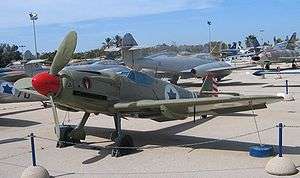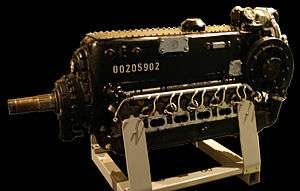Avia S-199
| S-199 | |
|---|---|
 | |
| Role | Fighter aircraft |
| Manufacturer | Avia |
| Designer | Messerschmitt |
| First flight | March 1947 |
| Retired | 1957 |
| Primary users | Czechoslovak Air Force Israeli Air Force |
| Produced | 1947–1949 |
| Number built | 603 |
| Developed from | Messerschmitt Bf 109 |
The Avia S-199 is a propeller-driven fighter aircraft built after World War II, notable as the first fighter obtained by the Israeli Air Force, and used during the 1948 Arab-Israeli War.
Constructed in Czechoslovakia, with parts and plans left over from Luftwaffe aircraft production, the aircraft had numerous problems and was generally unpopular with its pilots. Czechoslovak pilots nicknamed it Mezek ("Mule"), while in Israel it was officially known as the Sakeen ("knife" in Hebrew). In practice, the aircraft was more often called Messerschmitt or Messer (which also means "knife", in German and Yiddish).
Design and development


Avia continued building Messerschmitt Bf 109G-6s after the war under the Avia S-99 name, at two aircraft factories in Czechoslovakia: one of them officially called závod Avia (Avia Plant) (1946–48) and závod Avia-Jiřího Dimitrova (Avia-George Dimitroff-Plant, 1948–49) in Čakovice near Prague, as a postwar corporative part of the Automobilové závody, n.p. [Automotive Works, National Corp.]. The other was named závod Vysočany (Vysočany Plant, 1948–49) in Prague, as a corporative part of Letecké závody, n.p. [Aviation Works, National Corp.] but soon ran out of the 109's Daimler-Benz DB 605 engine after many were destroyed during an explosion at a warehouse in Krásné Březno.
The S-199 continued to use the Bf 109G airframe but, with none of the original engines available, an alternative engine had to be used. It was decided that as a replacement for the original engine, the aircraft would use the same (Junkers Jumo 211 F) engine and propeller as the Heinkel He 111 bomber. The resulting combination of parts was an aircraft with extremely poor handling qualities. The substitute engine with the propeller lacked the responsiveness of the Daimler-Benz unit and the torque created by the massive paddle-bladed propeller made control very difficult. This, in combination with the 109's narrow-track undercarriage, made landings and takeoffs extremely hazardous.
The Daimler-Benz DB 605 engine allowed for a central cannon mount (Motorkanone in German) that fired through the propeller spinner. This was not possible with the Junkers Jumo 211, and so the S-199 used a version of the Luftwaffe's Rüstsatz VI modification kit, which consisted of a pair of MG 151 cannon, one each in a gun pod, beneath each wing. This further impinged on the aircraft's performance. A final hidden danger lay in the gun synchronizer for the cowl-mounted MG 131 machine guns, which did not work as it was meant to, leading a few Israeli aircraft to shoot off their own propellers.[1]
Around 550 S-199s were built, including a number of conversion trainers designated CS-199 (armed) and C-210 (unarmed). The first flight took place in March 1947, and production ended in 1949. The last examples were withdrawn from Czechoslovak service (with their National Security Guard) in 1957. There may be some argument that the S-199's difficult handling was exacerbated by inadequately trained pilots in type, and was not as difficult to land and take off when flown by pilots competently trained in the type, considering the type was used for ten years in Czechoslovakia.
Operational history
Israeli service
.png)
Israeli agents negotiated the purchase of Avia S-199s from the Czechoslovak government in defiance of an arms embargo that Israel faced at the time. Twenty-five aircraft were obtained and all but two were eventually delivered. The price for a fully equipped plane was $190,000.[2] The first examples arrived on 20 May 1948, six days after Israel's declaration of independence and five days after the commencement of hostilities by Egypt. Forming Israel's first fighter squadron, they were assembled and sent into combat for the first time on May 29, attacking the Egyptian army between Isdud and the Ad Halom bridge, south of Tel Aviv. A few days later, on 3 June, taking off from Herzliya Airport[3] the type scored the Israeli Air Force's first aerial victories when Modi Alon shot down a pair of Royal Egyptian Air Force C-47s which had just bombed Tel Aviv.[4][5]
The type proved unreliable and performed poorly in combat. However, the maintenance and flying difficulties may have been exacerbated by inexperience and the lack of training in type for both flying and maintenance. Furthermore, maintenance problems meant that no more than five were typically airworthy at any one time. The type scored victories over its opponents, including the Spitfire.[6][7] The Avias were mostly withheld from service by the end of October, at which time only six remained operational. The S-199 continued making sporadic sorties until mid-December.
Variants
- Avia S-99
- Messerschmitt Bf 109G-6 variant assembled postwar in Czechoslovakia. Avia factory designation was C.10, 21 aircraft completed.
- Avia CS-99
- Training variant of Avia S-99 based on the Messerschmitt Bf 109G-12 variant. Avia factory designation was C.10, 23 aircraft completed.
- Avia S-199
- Avia S-99 powered by Junkers Jumo 211F engine, main production variant. Avia factory designation was C.210, 559 aircraft completed.
- Avia CS-199
- Two-seat training variant rebuilt from Avia S-199.
- Avia D-199
- Reconnaissance version.
Operators
- Czechoslovakian Air Force
- Czechoslovakian National Security Guard
Surviving aircraft
- Czech Republic
- UC-26 – CS-199 on static display at the Prague Aviation Museum in Kbely, Prague. It is serial number 565.[8]
- UF-25 – S-199 on static display at the Prague Aviation Museum in Kbely, Prague. It is serial number 178.[8]
- Israel
- D-112 – S-199 on static display at the Israeli Air Force Museum at Hatzerim Israeli Air Force Base near Hatzerim, South District.[9]
Specifications (S-199)
General characteristics
- Crew: one
- Length: 8.94 m (29 ft 4 in)
- Wingspan: 9.92 m (32 ft 6 in)
- Height: 2.59 m (8 ft 6 in)
- Wing area: 16.2 m2 (174 ft2)
- Empty weight: 2,650 kg (5,840 lb)
- Max. takeoff weight: 3,740 kg (8,245 lb)
- Powerplant: 1 × Junkers Jumo 211F liquid-cooled inverted V-12, 986 kW (1,340 PS – 1322 hp)
Performance
- Maximum speed: 590 km/h (320 kn, 370 mph)
- Combat radius: 850 km (530 mi)
- Service ceiling: 8,686 m (28,500 ft)
- Rate of climb: 11 m/s (2,200 ft/min)
- Wing loading: 231 kg/m2 (47.3 lb/ft2)
- Power/mass: 321 W/kg (0.195 hp/lb)
Armament
- Guns:
- 2× 13 mm MG 131 machine guns
- 2× MG 151/20 cannons
- Bombs:
- 1× 250 kg (551 lb) or
- 4× 70 kg (155 lb) bombs
See also
Related development
Aircraft of comparable role, configuration and era
Related lists
References
- ↑ Lande, D.A. (2000). Messerschmitt 109. Warbird History. MBI Publishing Company. p. 116. ISBN 0-7603-0803-9.
- ↑ Ilan, Amitzur (1996). The Origin of the Arab-Israeli Arms Race. Arms, Embargo, Military Power and Decision in the 1948 Palestine War, New York University Press, p. 169
- ↑ How Nazi Fighter Planes Saved Israel War Is Boring, 2016-15-08 Archived 2016-09-07 at the Wayback Machine.
- ↑ Aloni, Shlomo (2001). Arab–Israeli Air Wars. Osprey Publishing. p. 11. ISBN 1-84176-294-6.
- ↑ Norton, Bill (2004). Air War on the Edge – A History of the Israel Air Force and its Aircraft since 1947. Midland Publishing. pp. 110–12. ISBN 1-85780-088-5.
- ↑ Nordeen, Lon (1990). Fighters Over Israel, The Story of the Israeli Air Force from the War of Independence to the Bekaa Valley. Guild Publishing.
- ↑ "Attributed Israeli Air Combat Victories". Safarikovi. Retrieved September 8, 2011.
- 1 2 "Avia S-199 (čs. verze Messerschmitt Bf 109G/K) - stíhací letoun". Vojenský Historický Ústav Praha (in Czech). Vojenský Historický Ústav. Archived from the original on 15 July 2011. Retrieved 25 April 2017.
- ↑ "Airframe Dossier - Messerschmitt-Avia CS-199, s/n D-112 IDF, c/n 782358". Aerial Visuals. AerialVisuals.ca. Retrieved 24 April 2017.
External links
| Wikimedia Commons has media related to Avia S-199. |
- Avia S 199 Mezek, o Messerschmitt tchecoslocavo [The Avia S-99 and the Avia S-199] (in Portuguese) .
- 101 Squadron's Avia S-199s
- Valka.cz forum with more pictures and further information
- Yaakov, Katz (July 16, 2012). "'It was all destiny' – One of last surviving founders of IAF recalls mission that stopped Egypt from advancing on Tel Aviv". The Jerusalem Post.
- Avia S-199, Jewish Virtual Library